 W
WAfter the United Kingdom, France, and Italy signed with Germany the Munich Agreement on 30 September 1938, which "provided 'cession to Germany of the Sudeten German territory' of Czechoslovakia, despite existence of the 1924 alliance agreement and 1925 military pact between France and the Czechoslovak Republic, for which it is also known also as the Munich Betrayal," almost a year later, the Soviet Union signed a non-aggression pact with Nazi Germany on 23 August 1939. In addition to stipulations of non-aggression, the treaty included a secret protocol that divided territories of Romania, Poland, Lithuania, Latvia, Estonia, and Finland into German and Soviet Union "spheres of influence", anticipating potential "territorial and political rearrangements" of these countries. In October and November 1940, German-Soviet talks about the potential of joining the Axis took place in Berlin, nothing came from the talks since Hitler's Ideological goal was Lebensraum in the East.
 W
WBetween October 1940 and February 1942, in spite of the ongoing German attack on the Soviet Union in June 1941, the Red Army, in particular the Soviet Air Force, as well as Soviet military-related industries were subjected to purges by Stalin.
 W
WThe Anglo-Soviet Agreement was a formal military alliance that was signed by the United Kingdom and the Soviet Union against Nazi Germany on July 12, 1941, shortly after the beginning of Operation Barbarossa, the German invasion of the Soviet Union. Both powers pledged to assist each other and not to make a separate peace with Germany. The military alliance was to be valid until the end of World War II.
 W
WThe Soviet hospital ship Armenia was a transport ship operated by the Soviet Union during World War II to carry both wounded soldiers and military cargo. It had originally been built as a passenger ship for operations on the Black Sea.
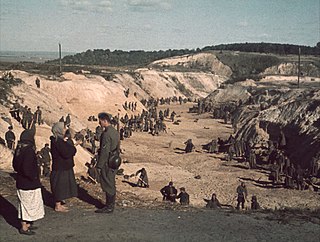 W
WBabi Yar is a ravine in the Ukrainian capital Kyiv and a site of massacres carried out by Nazi Germany's forces during its campaign against the Soviet Union in World War II. The first and best documented of the massacres took place on 29–30 September 1941, killing approximately 33,771 Jews. The decision to kill all the Jews in Kyiv was made by the military governor Generalmajor Kurt Eberhard, the Police Commander for Army Group South, SS-Obergruppenführer Friedrich Jeckeln, and the Einsatzgruppe C Commander Otto Rasch. Sonderkommando 4a as the sub-unit of Einsatzgruppe C, along with the aid of the SD and Order Police battalions with the Ukrainian Auxiliary Police backed by the Wehrmacht, carried out the orders. Sonderkommando 4a and the 45th Battalion of the German Order Police conducted the shootings. Servicemen of the 303rd Battalion of the German Order Police at this time guarded the outer perimeter of the execution site.
 W
WThe Battle of Petrikowka took place between 27 and 30 September 1941, during World War II. Fought between Italian and Soviet forces, it was the first significant engagement involving the Italian Expeditionary Corps in Russia.
 W
WThe bombing of Gorky by the German Luftwaffe was the most destructive attack on Soviet war production on the Eastern Front in World War II. It lasted intermittently from October 1941 - June 1943, with 43 raids carried out.
 W
WThe Battle at Borodino Field was a part of the Battle of Moscow, on the Eastern Front of World War II. While referring to the battle in Russian, the Borodino Field is actually more commonly applied rather than just Borodino, cf. Georgy Zhukov.
 W
WThe Continuation War, also known as Second Soviet-Finnish war, was a conflict fought by Finland and Nazi Germany, against the Soviet Union (USSR) from 1941 to 1944, as a part of World War II. In Soviet historiography, the war was called the Finnish Front of the Great Patriotic War. Germany regarded its operations in the region as part of its overall war efforts on the Eastern Front and provided Finland with critical material support and military assistance, including economic aid.
 W
WEvacuation in the Soviet Union was the mass migration of western Soviet citizens and its industries eastward as a result of Operation Barbarossa, the German military invasion of June 1941. Nearly sixteen million Soviet civilians and over 1,500 large factories were moved to areas in the middle or eastern part of the country by the end of 1941.
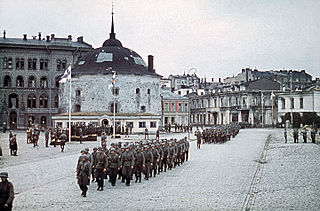 W
WThe Finnish invasion of the Karelian Isthmus refers to a military campaign carried out by Finland in 1941. It was part of what is commonly referred to as the Continuation War. Early in the war Finnish forces liberated the Karelian Isthmus. It had been ceded to the Soviet Union on 13 March 1940, in the Moscow Peace Treaty, which marked the end of the Winter War. Later, in the summer of 1944, the Soviet Union reconquered the southern part of the isthmus in the Vyborg–Petrozavodsk Offensive.
 W
WPrior to the invasion of the Soviet Union during World War II, the German armed forces were not aware of two newly developed Soviet tanks, the T-34 and the KV. As a result, they were surprised when they met them in combat for the first time in June 1941. The Germans' standard anti-tank weapons were found to be ineffective against these new Soviet vehicles. This experience prompted a notable leap in tank development in Nazi Germany, mainly in an effort to counter these new threats.
 W
WThe German–Soviet Border and Commercial Agreement, signed on January 10, 1941, was a broad agreement which settled border disputes, and continued raw materials and war machine trade between the Soviet Union and Nazi Germany. The agreement continued the countries' relationship that started in 1939 with the Molotov–Ribbentrop Pact, which contained secret protocols that divided Eastern Europe between the Soviet Union and Germany. The relationship had continued with the subsequent invasions by Germany and the Soviet Union of that territory. The agreement contained additional secret protocols, settling a dispute regarding land in Lithuania, which was had been split between both countries. The agreement continued the Nazi–Soviet economic relations that had been expanded by the 1939 German–Soviet Commercial Agreement and the more comprehensive 1940 German–Soviet Commercial Agreement.
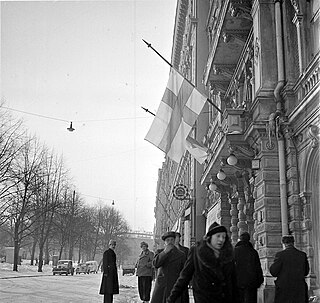 W
WThe Interim Peace was a short period in the history of Finland during the Second World War. The term is used for the time between the Winter War and the Continuation War, lasting a little over 15 months, from 13 March 1940 to 24 June 1941. The Moscow Peace Treaty was signed by Finland and the Soviet Union on 12 March 1940 and it ended the 105-day Winter War.
 W
WThe Anglo-Soviet invasion of Iran or Anglo-Soviet invasion of Persia was the joint invasion of the neutral Imperial State of Iran by the United Kingdom and the Soviet Union in August 1941. The invasion, codenamed Operation Countenance, was largely unopposed by the numerically and technologically outmatched Iranian forces. The multi-pronged coordinated invasion took place along Iran's borders with modern Iraq, Azerbaijan and Turkmenistan, with fighting beginning on 25 August and ending on 31 August when the Iranian government formally agreed to surrender, having already agreed to a ceasefire on 30 August.
 W
WThe June Uprising was a brief period in the history of Lithuania between the first Soviet occupation and the Nazi occupation in late June 1941. Approximately one year earlier, on June 15, 1940, the Red Army occupied Lithuania and the unpopular Lithuanian Soviet Socialist Republic was soon established. Political repression and terror were used to silence its critics and suppress any resistance. When Nazi Germany attacked the Soviet Union on June 22, 1941, a diverse segment of the Lithuanian population rose up against the Soviet regime, declared renewed independence, and formed the short-lived Provisional Government. Two large Lithuanian cities, Kaunas and Vilnius, fell into the hands of the rebels before the arrival of the Wehrmacht. Within a week, the German Army took control of the whole of Lithuania. The Lithuanians greeted the Germans as liberators from the repressive Soviet rule and hoped that the Germans would re-establish their independence or at least allow some degree of autonomy. No such support came from the Nazis, who steadily replaced Lithuanian institutions with their own administration. The Reichskommissariat Ostland was established at the end of July 1941. Deprived of any real power, the Provisional Government disbanded itself on August 5.
 W
WThe 1st Battle of Kharkov, so named by Wilhelm Keitel, was the 1941 battle for the city of Kharkiv Ukrainian SSR during the final phase of Operation Barbarossa between the German 6th Army of Army Group South and the Soviet Southwestern Front. The Soviet 38th Army was ordered to defend the city while its factories were dismantled for relocation farther east.
 W
WKurapaty is a wooded area on the outskirts of Minsk, Belarus, in which a vast number of people were executed between 1937 and 1941 during the Great Purge by the Soviet secret police, the NKVD.
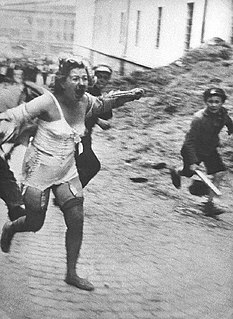 W
WThe Lviv pogroms were the consecutive pogroms and massacres of Jews in June and July 1941 in the city of Lwów in Eastern Poland/Western Ukraine. The massacres were perpetrated by Ukrainian nationalists, German death squads, and urban population from 30 June to 2 July, and from 25 to 29 July, during the German invasion of the Soviet Union. Thousands of Jews were killed both in the pogroms and in the Einsatzgruppen killings.
 W
WThe Battle of Moscow was a military campaign that consisted of two periods of strategically significant fighting on a 600 km (370 mi) sector of the Eastern Front during World War II. It took place between October 1941 and January 1942. The Soviet defensive effort frustrated Hitler's attack on Moscow, the capital and largest city of the Soviet Union. Moscow was one of the primary military and political objectives for Axis forces in their invasion of the Soviet Union.
 W
WOperation München was the Romanian codename of a joint German-Romanian offensive during the German invasion of the Soviet Union in World War II, with the primary objective of recapturing Bessarabia, Northern Bukovina and the Hertsa region, ceded by Romania to the Soviet Union a year before. The operation concluded successfully after 24 days of fighting. Axis formations involved included the Romanian Third and the Fourth Armies and the German Eleventh Army. The invasion was followed by a genocide against the Jewish population of Bessarabia.
 W
WThe Soviet occupation of the Baltic states covers the period from the Soviet–Baltic mutual assistance pacts in 1939, to their invasion and annexation in 1940, to the mass deportations of 1941.
 W
WThe occupation of the Baltic states involved the June 1940 invasion of the Red Army, and the subsequent military occupation of Estonia, Latvia and Lithuania by the Soviet Union, under the leadership of Stalin and auspices of the August 1939 Nazi-Soviet Pact that had been signed immediately before the outbreak of World War II. The three countries were then annexed into the Soviet Union as constituent "republics" in August 1940, though United States and most other Western countries never recognised this incorporation, considering it illegal. On 22 June 1941, Nazi Germany attacked the Soviet Union and within weeks occupied the Baltic territories. In July 1941, the Third Reich incorporated the Baltic territory into its Reichskommissariat Ostland. As a result of the Red Army's Baltic Offensive of 1944, the Soviet Union recaptured most of the Baltic states and trapped the remaining German forces in the Courland pocket until their formal surrender in May 1945.
 W
WThe Battle of Rostov (1941) was a battle of the Eastern Front of World War II, fought around Rostov-on-Don between the Army Group South of Nazi Germany and the Southern Front of the Soviet Union.
 W
WThe siege of Sevastopol also known as the defence of Sevastopol or the Battle of Sevastopol was a military engagement that took place on the Eastern Front of the Second World War. The campaign was fought by the Axis powers of Germany and Romania against the Soviet Union for control of Sevastopol, a port in the Crimea on the Black Sea. On 22 June 1941 the Axis invaded the Soviet Union during Operation Barbarossa. Axis land forces reached the Crimea in the autumn of 1941 and overran most of the area. The only objective not in Axis hands was Sevastopol. Several attempts were made to secure the city in October and November 1941. A major attack was planned for late November, but heavy rains delayed it until 17 December 1941. Under the command of Erich von Manstein, Axis forces were unable to capture Sevastopol during this first operation. Soviet forces launched an amphibious landing on the Crimean peninsula at Kerch in December 1941 to relieve the siege and force the Axis to divert forces to defend their gains. The operation saved Sevastopol for the time being, but the bridgehead in the eastern Crimea was eliminated in May 1942.
 W
WThe siege of Odessa, known to the Soviets as the defence of Odessa, lasted from 8 August until 16 October 1941, during the early phase of Operation Barbarossa, the Axis invasion of the Soviet Union during World War II.
 W
WThe Sikorski–Mayski Agreement was a treaty between the Soviet Union and Poland that was signed in London on 30 July 1941. Its name is taken from its two most notable signatories: the prime minister of Poland, Władysław Sikorski, and the Soviet ambassador to the United Kingdom, Ivan Mayski.
 W
WThe first Battle of Smolensk was a battle during the second phase of Operation Barbarossa, the Axis invasion of the Soviet Union, in World War II. It was fought around the city of Smolensk between 10 July and 10 September 1941, about 400 km (250 mi) west of Moscow. The Ostheer had advanced 500 km (310 mi) into the USSR in the 18 days after the invasion on 22 June 1941.
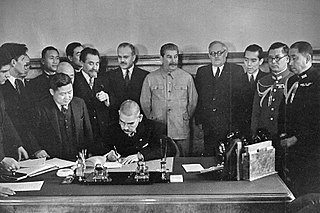 W
WThe Soviet–Japanese Neutrality Pact , also known as the Japanese–Soviet Non-aggression Pact , was a non-aggression pact between the Soviet Union and the Empire of Japan signed on April 13, 1941, two years after the conclusion of the Soviet-Japanese Border War. The agreement meant that for most of World War II, the two nations fought against each other's allies but not against each other. In 1945, late in the war, the Soviets scrapped the pact and joined the Allied campaign against Japan.
 W
WThe Soviet evacuation of Tallinn, also called Juminda mine battle, Tallinn disaster or Russian Dunkirk, was a Soviet operation to evacuate the 190 ships of the Baltic Fleet, units of the Red Army, and pro-Soviet civilians from the fleet's encircled main base of Tallinn in Soviet-occupied Estonia during August 1941. Near Juminda peninsula Soviet fleet ran into minefield that had been laid by Finnish and German navies, and were repeatedly attacked by aircraft and torpedo boats, suffering massive losses.
 W
WTuman was a Soviet patrol boat that engaged a battle with German destroyers during World War II, fought in Arctic waters of the Barents Sea in 1941.
 W
WThe Battle of Uman was the World War II German offensive in Uman, Ukraine against the 6th and 12th Soviet Armies. In a three-week period, the Wehrmacht encircled and annihilated the two Soviet armies
 W
WThe winter campaign of 1941–1942 from 5 December 1941 to 7 May 1942 was the name given by Soviet military command to the period that marked the commencement of the Moscow Strategic Offensive Operation. The opening phase of the Red Army strategic counter-offensive operations in the Soviet Union was a major albeit costly Soviet victory.